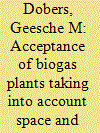|
|
|
Sort Order |
|
|
|
Items / Page
|
|
|
|
|
|
|
| Srl | Item |
| 1 |
ID:
169876


|
|
|
|
|
| Summary/Abstract |
As part of Germany's energy transition, enormous efforts are being made to transform the German energy supply to renewable energies. While much of the energy supply from renewables is wind and solar power, biogas contributes on third position a considerable share due to substantial state subsidies. The transformation to renewable energies leads to notable landscape changes that should be taken into consideration when studying the acceptance of renewable energy plants. We do this by adding spatial information to data from an online survey (N = 942) questioning the acceptance of biogas plants. The density of and proximity to existing biogas plants as well as the intensity of maize cultivation in the vicinity of respondents is integrated into the analysis together with more conventional influencing factors such as place attachment and attitudes. Results show that attitudes have the strongest explanatory power but spatial variables, particularly maize intensity, contribute significantly, too. Place attachment does not show reliable effects. The results demonstrate that spatial data can be useful in the analysis of survey data, for instance, in an environmental context. They also show that diversification of the raw materials used for fermentation in biogas plants might be an important factor in improving their acceptance.
|
|
|
|
|
|
|
|
|
|
|
|
|
|
|
|
| 2 |
ID:
171429


|
|
|
|
|
| Summary/Abstract |
Nuclear energy facility development in China has become controversial amid widespread environmental concerns. The present study examines how environmental beliefs influence public acceptance of nuclear energy in the context of China. In the current study, we test the mediation effect of nuclear engagement and test place attachment as a moderator based on cognitive-affective processing system theory. Our data have been obtained from an online survey, using a sample consisting of 516 individuals with experience in the public participation activities in Chinese nuclear power plant projects. The empirical results show that environmental beliefs are positively and significantly correlated to public acceptance of nuclear energy through the individuals’ nuclear engagement. Place attachment negatively and significantly moderates the direct impact of environmental beliefs on nuclear engagement. In the meantime, the mediating effect of nuclear engagement is weaker when place attachment is high. Significant practical implications are provided in our study for the Chinese governmental authorities.
|
|
|
|
|
|
|
|
|
|
|
|
|
|
|
|
| 3 |
ID:
176745


|
|
|
|
|
| Summary/Abstract |
Although many new nuclear power plant (NPP) projects, such as the addition of a new reactor, have been proposed at the locations of existing nuclear installations, little attention has been given to research on the acceptance of such rebuilding projects by local residents living near the existing NPPs. The present study develops a theoretical model that examines the influences of environmental concern, place attachment, perceived benefit, and perceived risk on local acceptance of rebuilding NPPs. The study also divides perceived benefit into two dimensions, namely, perceived general benefit and perceived local benefit. Using data from an online questionnaire-based survey in China, the results indicate that for the surveyed local residents, rebuilding acceptance is positively influenced by perceived local benefit and perceived general benefit but is negatively affected by perceived risk. Perceived local benefit is the dominant factor influencing local rebuilding acceptance. Contrary to expectations, environmental concern positively affects the perceived benefit, which in turn positively affects local rebuilding acceptance. Moreover, place attachment positively affects the perceived benefit and negatively affects the perceived risk, which in turn positively affects local rebuilding acceptance. Based on these findi
|
|
|
|
|
|
|
|
|
|
|
|
|
|
|
|
| 4 |
ID:
166973


|
|
|
|
|
| Summary/Abstract |
This paper documents different attitudes towards local renewable energy technology (RET) projects in Denmark among two key RET stakeholder groups, permanent area residents (PRs) and second home owners (SHOs). It does so via survey data collected from almost 2000 respondents during a Danish near-shore wind farm tender. Judging by this data, local PRs are positive towards the planned local RETs, while SHOs are less so. This emphasizes that potential RET project stakeholders and stakeholder groups may have very different RET project perceptions and opinions. The planned RET projects were subject to widespread critique in the public and political RET project related debate, but the documented PR RET project support was rather silent support. This is a noteworthy inconsistency calling for further research. Drawing upon research insights from the interdisciplinary socially focused energy transitions body of literature, the paper suggests that particular uses of and attachments to particular places may inform stakeholder perceptions of RET related local change. The research findings have significant implications for RET planning, practice and policy more broadly.
|
|
|
|
|
|
|
|
|
|
|
|
|
|
|
|
| 5 |
ID:
191108


|
|
|
|
|
| Summary/Abstract |
Although the influence of mobility on place attachment has received attention in the literature, this relationship varies between groups. Unlike those who move to enjoy their retirement, for example, older migrants arriving in Shenzhen come to the city ‘passively,’ drawn by the needs of their children. This paper advances understanding of the concept of place attachment by illustrating the relationships between its components. Analysis of interview and questionnaire responses revealed the following relationships between three focal components of place attachment. Place dependence first directly influenced affective attachment and then indirectly affected place identity. Leisure involvement had a positive impact on place dependence and affective attachment but no direct effect on place identity. Residential satisfaction was an antecedent of all three focal dimensions of place attachment. No direct relationship was found between leisure involvement and residential satisfaction.
|
|
|
|
|
|
|
|
|
|
|
|
|
|
|
|
| 6 |
ID:
117776


|
|
|
| 7 |
ID:
188945


|
|
|
|
|
| Summary/Abstract |
This article expands on the usability of the concepts of “place making” and “place attachment” as recently developed in urban studies research in the context of housing insecurity of marginalized communities in today’s neo-liberal city. Particularly, against the growing threat of urban evictions, the article utilizes a transdisciplinary approach, showing the relevance of both concepts for (a) a better understanding of bottom-up processes of spatial production and attempts to create a sense of place on the part of such communities, and (b) offering an innovative legal strategy for doing justice to these communities in terms of their compensation rights, especially where a title to land has not been registered on a private basis. These issues are critically examined on the site-related case of the Givat-Amal quarter in Tel Aviv, Israel. This district is now under actual final threat of forced evictions following seven conflicted decades with the state, municipal authorities and private entrepreneurs. Our transdisciplinary study is based on qualitative methodologies in human geography such as fieldwork, visual evidence, and interviews, with a glimpse into philosophy. It is equally based on revisiting “traditional” legal property rights through the lens of post-liberal human rights analysis. The argument can apply to many situations of forced evictions across Africa, Latin America, and the West itself.
|
|
|
|
|
|
|
|
|
|
|
|
|
|
|
|
| 8 |
ID:
171915


|
|
|
|
|
| Summary/Abstract |
While internal migration in contemporary China ascribes a great change to urban China's demographic composition, social structures and economic development trajectories, it is yet to restructure the formal definitions of urban identity and belonging, which are still dominated by the household registration system (hukou). The paper suggests that as a result of changes in the political, economic, demographic and social contexts within which China's internal migration develops, there emerge a crucial need to re‐examine the crude forms of determining identity and belonging, questioning the addressing of spatiality within the existing mechanisms (such as hukou system or the shiminhua discourse). To do so, the paper argues that the existing de‐territorialisation of the migration experience has to be replaced with a more nuanced understanding of how spatial practices and conceptualisations shape migrants’ experiences, as it is becoming imperative to develop a new framework that is more sensitive to migrants’ lived process of identification and belonging, especially as these traverse multiple geographies and spatial scales. This close engagement with migrants’ spatiality can then be used as a base from which to engage with a more complex view of migrants’ spatial and social relatedness, as well as the development of their urban belonging and identity.
|
|
|
|
|
|
|
|
|
|
|
|
|
|
|
|
|
|
|
|
|